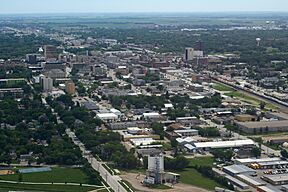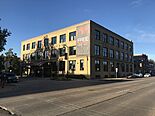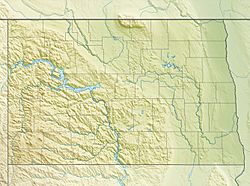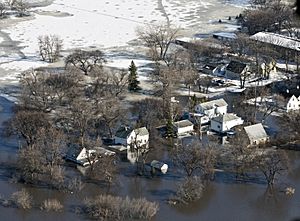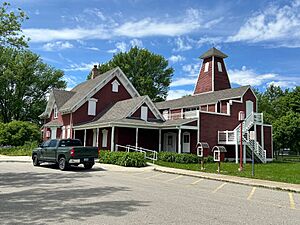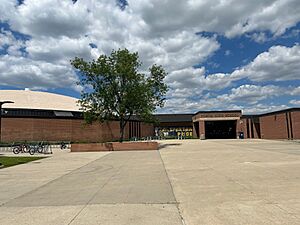Fargo, North Dakota facts for kids
Quick facts for kids
Fargo, North Dakota
|
||
|---|---|---|
|
Downtown Fargo
Fargo Theatre
Plains Art Museum
deLendrecie's Department Store
RDO Building
Veterans Memorial Bridge
|
||
|
||
| Country | United States | |
| State | North Dakota | |
| County | Cass | |
| Founded | 1871 | |
| Incorporated | 1874 | |
| Named for | William Fargo | |
| Area | ||
| • City | 50.835 sq mi (131.662 km2) | |
| • Land | 50.834 sq mi (131.659 km2) | |
| • Water | 0.001 sq mi (0.003 km2) | |
| Elevation | 906 ft (276 m) | |
| Population
(2020)
|
||
| • City | 125,990 | |
| • Estimate
(2023)
|
133,188 | |
| • Rank | US: 218th ND: 1st |
|
| • Density | 2,620/sq mi (1,012/km2) | |
| • Urban | 216,214 (US: 178th) | |
| • Urban density | 2,781.6/sq mi (1,074.0/km2) | |
| • Metro | 262,620 (US: 189th) | |
| • Metro density | 93.4/sq mi (36.08/km2) | |
| Demonym(s) | Fargoan | |
| GDP | ||
| • Metro | $18.792 billion (2022) | |
| Time zone | UTC–6 (Central (CST)) | |
| • Summer (DST) | UTC–5 (CDT) | |
| ZIP Codes |
58102–58109, 58121–58122, 58124–58126
|
|
| Area code(s) | 701 | |
| FIPS code | 38-25700 | |
| GNIS feature ID | 1036030 | |
| Highways | I-29, I-94, US 10, US 52, US 81 | |
| Sales tax | 7.5% | |
Fargo is the largest city in the state of North Dakota, USA. It is also the main city of Cass County. In 2020, about 125,990 people lived there. By 2023, this number grew to an estimated 133,188 people.
Fargo is part of a larger area called Fargo–Moorhead. This area includes its twin city of Moorhead, Minnesota. Together, they had a population of 248,591 in 2020.
Fargo was started in 1871 next to the Red River of the North. Today, it is a key center for shopping, healthcare, education, and industry in its region. North Dakota State University is also located in Fargo.
Contents
History of Fargo
How Fargo Began
The land where Fargo is now was once part of Sioux (or Dakota) territory. In the 1870s and 1880s, steamboats used to stop here while traveling on the Red River.
The city was first called "Centralia." But it was later renamed "Fargo" after William Fargo. He was a director for the Northern Pacific Railway and started the Wells Fargo Express Company.
When Fargo was first settled, there were two unofficial towns. One was "Fargo on the Prairie," which was well-organized by railroad engineers. The other was "Fargo in the Timber," which was known for being wild and lawless. Eventually, "Fargo in the Timber" was shut down by authorities. The modern city of Fargo grew from "Fargo on the Prairie." When the Northern Pacific Railroad arrived, Fargo became known as the "Gateway to the West."
In the 1880s, Fargo became known for its easy divorce laws. On June 7, 1893, a huge fire destroyed 31 blocks of downtown Fargo. But the city was quickly rebuilt! Within a year, more than 246 new buildings were made of brick, and new streets and a water system were put in place.
North Dakota State University was founded in 1890. It was first called the North Dakota Agricultural College. It became a university in 1960.
Fargo in the 1900s
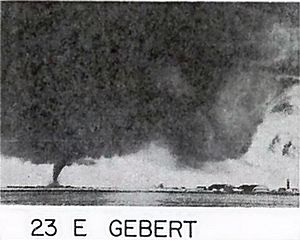
In the early 1900s, the car industry grew in Fargo. In 1905, the Pence Automobile Company started here. It once sold almost a third of all Buick cars! Ford also had a factory in Fargo that made about 70 cars a day by 1917. This factory stayed open until 1956.
In 1910, former President Theodore Roosevelt visited Fargo. He spoke to 30,000 people and said that his time living in North Dakota helped him become president.
After World War II, Fargo grew very quickly. In 1957, a strong tornado hit the city. It destroyed a large part of northern Fargo. A famous tornado expert, Ted Fujita, studied photos of this tornado. His studies helped him create ideas about "wall clouds" and "tail clouds," which are important terms for understanding tornadoes.
Two major highways, I-29 and I-94, were built. This made travel easier and helped Fargo grow to the south and west. In 1972, the West Acres Shopping Center, the biggest mall in North Dakota, was built near where the two highways meet. This mall helped more stores open in the area.
Recent Times in Fargo
Fargo has kept growing steadily. Since the mid-1980s, most new homes have been built in the south and southwest parts of the city. This is because of natural limits on the north side. The main shopping areas in the southwest have also grown a lot.
Downtown Fargo has been improved with new buildings and businesses. This happened because the city and private companies invested in the area. Older neighborhoods have also been made better through housing projects.
NDSU has become a big research university. It is a huge part of Fargo's identity and economy. Many students live near the university. NDSU has also opened buildings and apartments downtown. The NDSU Bison Football team is very popular with many people in the area.
In recent years, Fargo has become a center for technology and healthcare. Companies like Microsoft and Sanford Health have built large offices here. Since the late 1990s, the Fargo-Moorhead area has had one of the lowest unemployment rates in the United States.
Geography of Fargo
Fargo is a main city in the Fargo-Moorhead, ND–MN Combined Statistical Area. This area also includes Moorhead, West Fargo, and Dilworth.
Fargo is on the western bank of the Red River of the North. It is in a very flat area called the Red River Valley. This valley was formed when a huge glacial lake, Lake Agassiz, dried up about 9,300 years ago. The soil left behind by Lake Agassiz makes the land around Fargo some of the best in the world for farming.
The Red River flows north, which can cause problems with floods. When snow melts and river ice breaks up, it can create ice dams. This makes the river overflow. Because the land around Fargo is so flat, the water spreads out widely.
Since a big flood in 2009, Fargo and Moorhead have worked hard to prevent floods. Now, only a very large flood would cause serious worry. A huge project called the FM Diversion is being built. When it is finished, it will protect the area from very large floods for a long time.
The city has a total area of about 50.8 square miles (131.6 square kilometers). Almost all of this is land.
Fargo's Climate
Fargo has an extreme humid continental climate. This means it has very long, cold winters and warm to hot, humid summers. It is one of the coldest cities in the United States during winter. January, the coldest month, has an average temperature of about 9.2°F (–12.7°C). On average, it gets to 0°F (–18°C) or colder about 43 days a year. About 51.4 inches (131 cm) of snow falls each winter.
Spring and autumn are short and change a lot. Summers have many thunderstorms. July, the warmest month, has an average temperature of about 70.7°F (21.5°C). The temperature reaches 90°F (32°C) or higher about 12.7 days each year. Fargo gets about 24 inches (61 cm) of rain each year, mostly in the warmer months.
The coldest temperature ever recorded was -48°F (–44°C) in January 1887. The hottest was 114°F (46°C) in July 1936.
In 2011, Fargo won a poll by The Weather Channel as "America's Toughest Weather City." This was because of its blizzards, cold, and floods.
| Climate data for Fargo, North Dakota (Hector Int'l), 1991–2020 normals, extremes 1881–present | |||||||||||||
|---|---|---|---|---|---|---|---|---|---|---|---|---|---|
| Month | Jan | Feb | Mar | Apr | May | Jun | Jul | Aug | Sep | Oct | Nov | Dec | Year |
| Record high °F (°C) | 55 (13) |
66 (19) |
80 (27) |
100 (38) |
104 (40) |
104 (40) |
114 (46) |
106 (41) |
102 (39) |
97 (36) |
74 (23) |
65 (18) |
114 (46) |
| Mean maximum °F (°C) | 39.8 (4.3) |
42.0 (5.6) |
57.5 (14.2) |
78.3 (25.7) |
88.9 (31.6) |
92.4 (33.6) |
92.9 (33.8) |
92.2 (33.4) |
89.7 (32.1) |
79.5 (26.4) |
59.4 (15.2) |
42.6 (5.9) |
95.8 (35.4) |
| Mean daily maximum °F (°C) | 18.2 (−7.7) |
22.7 (−5.2) |
36.3 (2.4) |
54.1 (12.3) |
68.7 (20.4) |
78.1 (25.6) |
82.1 (27.8) |
80.7 (27.1) |
72.0 (22.2) |
55.8 (13.2) |
38.1 (3.4) |
24.0 (−4.4) |
52.6 (11.4) |
| Daily mean °F (°C) | 9.2 (−12.7) |
13.4 (−10.3) |
27.2 (−2.7) |
43.0 (6.1) |
56.6 (13.7) |
66.8 (19.3) |
70.7 (21.5) |
68.8 (20.4) |
60.0 (15.6) |
45.5 (7.5) |
29.5 (−1.4) |
15.7 (−9.1) |
42.2 (5.7) |
| Mean daily minimum °F (°C) | 0.2 (−17.7) |
4.1 (−15.5) |
18.1 (−7.7) |
31.9 (−0.1) |
44.4 (6.9) |
55.6 (13.1) |
59.4 (15.2) |
56.8 (13.8) |
48.1 (8.9) |
35.2 (1.8) |
20.9 (−6.2) |
7.5 (−13.6) |
31.8 (−0.1) |
| Mean minimum °F (°C) | −24.2 (−31.2) |
−18.8 (−28.2) |
−7.4 (−21.9) |
15.9 (−8.9) |
29.1 (−1.6) |
42.4 (5.8) |
47.3 (8.5) |
44.4 (6.9) |
31.7 (−0.2) |
19.6 (−6.9) |
1.3 (−17.1) |
−15.1 (−26.2) |
−25.0 (−31.7) |
| Record low °F (°C) | −48 (−44) |
−45 (−43) |
−34 (−37) |
−13 (−25) |
14 (−10) |
28 (−2) |
36 (2) |
32 (0) |
17 (−8) |
−4 (−20) |
−27 (−33) |
−39 (−39) |
−48 (−44) |
| Average precipitation inches (mm) | 0.71 (18) |
0.69 (18) |
1.25 (32) |
1.54 (39) |
3.09 (78) |
4.29 (109) |
3.07 (78) |
2.60 (66) |
2.68 (68) |
2.17 (55) |
0.97 (25) |
0.89 (23) |
23.95 (608) |
| Average snowfall inches (cm) | 10.3 (26) |
8.1 (21) |
9.2 (23) |
4.1 (10) |
0.0 (0.0) |
0.0 (0.0) |
0.0 (0.0) |
0.0 (0.0) |
0.0 (0.0) |
1.2 (3.0) |
6.8 (17) |
11.7 (30) |
51.4 (131) |
| Average precipitation days (≥ 0.01 in) | 8.9 | 7.5 | 7.7 | 8.2 | 11.4 | 11.8 | 9.7 | 8.6 | 8.7 | 8.5 | 7.6 | 10.0 | 108.6 |
| Average snowy days (≥ 0.1 in) | 9.5 | 7.6 | 5.5 | 2.3 | 0.1 | 0.0 | 0.0 | 0.0 | 0.0 | 1.2 | 5.4 | 10.2 | 41.8 |
| Average relative humidity (%) | 73.1 | 74.7 | 76.0 | 65.6 | 60.0 | 66.1 | 66.9 | 66.5 | 69.2 | 68.8 | 75.7 | 76.1 | 69.9 |
| Mean monthly sunshine hours | 140.9 | 153.9 | 212.3 | 241.6 | 283.2 | 303.2 | 350.2 | 313.2 | 231.2 | 178.9 | 113.1 | 107.4 | 2,629.1 |
| Percent possible sunshine | 51 | 53 | 58 | 59 | 61 | 64 | 73 | 71 | 61 | 53 | 40 | 40 | 59 |
| Average ultraviolet index | 1 | 2 | 3 | 5 | 6 | 8 | 8 | 7 | 5 | 3 | 1 | 1 | 4 |
| Source 1: NOAA (relative humidity and sun 1961–1990) | |||||||||||||
| Source 2: Weather Atlas (UV) | |||||||||||||
People of Fargo
| Historical population | |||
|---|---|---|---|
| Census | Pop. | %± | |
| 1880 | 2,693 | — | |
| 1890 | 5,664 | 110.3% | |
| 1900 | 9,589 | 69.3% | |
| 1910 | 14,331 | 49.5% | |
| 1920 | 21,961 | 53.2% | |
| 1930 | 28,619 | 30.3% | |
| 1940 | 32,580 | 13.8% | |
| 1950 | 38,256 | 17.4% | |
| 1960 | 46,662 | 22.0% | |
| 1970 | 53,365 | 14.4% | |
| 1980 | 61,383 | 15.0% | |
| 1990 | 74,111 | 20.7% | |
| 2000 | 90,599 | 22.2% | |
| 2010 | 105,549 | 16.5% | |
| 2020 | 125,990 | 19.4% | |
| 2023 (est.) | 133,188 | 26.2% | |
| U.S. Decennial Census 2020 Census |
|||

In 2022, Fargo had about 56,890 homes. Each home had about 2.14 people living in it. The average income for a household was $64,432. About 13.3% of the people in Fargo lived below the poverty line.
About 74.5% of people in Fargo have jobs. Also, 42.4% of the people have a college degree or higher. About 95.0% have a high school diploma.
The most common backgrounds reported by people in Fargo are:
- German (33.2%)
- Norwegian (22.6%)
- Irish (8.5%)
- African (5.1%)
- English (5.1%)
- French (3.5%)
- Italian (1.9%)
- Polish (1.8%)
- Scottish (0.9%)
The average age of people in Fargo is 31.5 years old.
Fargo's Population in 2020
| Race / ethnicity (NH = non-Hispanic) | Pop. 2000 | Pop. 2010 | Pop. 2020 | % 2000 | % 2010 | % 2020 |
|---|---|---|---|---|---|---|
| White alone (NH) | 84,660 | 93,889 | 98,062 | 93.44% | 88.95% | 77.83% |
| Black or African American alone (NH) | 908 | 2,809 | 10,882 | 1.00% | 2.66% | 8.64% |
| Native American or Alaska Native alone (NH) | 1,077 | 1,326 | 1,827 | 1.19% | 1.26% | 1.45% |
| Asian alone (NH) | 1,475 | 3,132 | 5,150 | 1.63% | 2.97% | 4.09% |
| Pacific Islander alone (NH) | 39 | 41 | 72 | 0.04% | 0.04% | 0.06% |
| Other race alone (NH) | 83 | 110 | 330 | 0.09% | 0.10% | 0.26% |
| Mixed race or multiracial (NH) | 1,190 | 1,934 | 4,997 | 1.31% | 1.83% | 3.97% |
| Hispanic or Latino (any race) | 1,167 | 2,308 | 4,670 | 1.29% | 2.19% | 3.71% |
| Total | 90,599 | 105,549 | 125,990 | 100.00% | 100.00% | 100.00% |
In 2020, Fargo had 125,990 people and 56,116 households. The city had about 2,530 people per square mile (977 per square kilometer).
The racial makeup of the city was:
- 78.93% White
- 8.76% African American
- 1.60% Native American
- 4.11% Asian
- 0.07% Pacific Islander
- 1.20% from other races
- 5.34% from two or more races
About 3.71% of the people were Hispanic or Latino. About 19.4% of residents were under 18 years old.
Fargo's Economy
Fargo's economy used to rely mostly on farming. But that has changed a lot. Today, Fargo has a growing economy based on:
- Food processing
- Manufacturing (making things)
- Technology
- Retail trade (stores)
- Higher education (colleges)
- Healthcare
Major Employers in Fargo
Here are some of the biggest employers in Fargo:
| # | Employer | Type of Business | # of Employees | Percentage |
|---|---|---|---|---|
| 1 | Sanford Health | Medical/Health Care | 9,229 | 12.31% |
| 2 | North Dakota State University | Higher Education | 2,267 | 3.02% |
| 3 | Fargo Public Schools | Education | 2,153 | 2.87% |
| 4 | West Fargo Public Schools in West Fargo | Education | 2,031 | 2.71% |
| 5 | Essentia Health | Medical/Health Care | 1,946 | 2.60% |
| 6 | Marvin Windows | Manufacturer | 1,800 | 2.40% |
| 7 | VA Health Care System | Medical/Health Care | 1,440 | 1.92% |
| 8 | Coborns Inc. (Hornbacher's & Cash Wise Foods) | Retail Grocery | 1,215 | 1.62% |
| 9 | City of Fargo | Government | 1,021 | 1.36% |
| 10 | Wex Health in West Fargo | Business/Productivity Software | 863 | 1.15% |
| — | Total employers | — | 23,965 | 31.98% |
Arts and Culture in Fargo
Most plays and events in Fargo are put on by the universities. But there are also private theater groups, like the Fargo-Moorhead Community Theatre (FMCT).
Music groups in the area include:
- The Fargo-Moorhead Opera
- The Fargo-Moorhead Symphony Orchestra
- The Fargo-Moorhead Youth Symphony
Fargo also has a dance company called the Fargo-Moorhead Ballet.
The Fargo Theatre is a beautiful old movie house from 1926. It shows new movies, film festivals, and hosts other community events. The Fargodome is a large arena that holds concerts, Broadway musicals, dance shows, sports events, and fairs.
The Winter Carnival in Fargo is a long-standing tradition that started in 1928.
The Plains Art Museum is the biggest art museum in North Dakota. It is in downtown Fargo and shows art from the region and from all over the country. It also has a large collection of art that stays there all the time.
Other museums in Fargo include:
- The Fargo Air Museum
- The Courthouse Museum
- The Roger Maris Museum (inside West Acres Shopping Center)
- The North Dakota State University Wall of Fame (inside the Fargo Scheels store)
The Children's Museum at Yunker Farm closed in 2021 after 30 years. But the rest of the property is still open to the public and is being improved.
The annual Downtown Fargo Street Fair is a lively event. It brings together many artists, craftspeople, and food vendors. It is North Dakota's largest free outdoor gathering.
Libraries in Fargo
The Fargo Public Library started in 1900. For many years, it was in a building paid for by Andrew Carnegie. In 1968, the library moved to a new building downtown. The old 1968 building was torn down, and a new main library opened in 2009.
The Fargo Public Library also has two other branches:
- The Dr. James Carlson Library in south Fargo
- The Northport branch in north Fargo
In 2014, people checked out over 1 million items from the Fargo Public Library. Books and magazines made up almost half of these items. Digital media and other non-print items were more than a third.
Museums in Fargo
- Fargo Air Museum – Shows planes from World War II and later. It also hosts special exhibits that travel to different places.
- Plains Art Museum – A big art museum in a historic building downtown. It shows art from the region and from all over the country.
- The Roger Maris Museum – A small, free museum about Roger Maris. He was a famous baseball player for the New York Yankees who lived in Fargo for a while. It has his things and a video about him.
- Maury Wills Museum – This museum is at Newman Outdoor Field. It honors Maury Wills, a former baseball player who coached for the RedHawks.
Theaters in Fargo
- Fargo-Moorhead Community Theatre – Puts on comedies, dramas, shows for young people, and musicals. Their theater is in Island Park, south of downtown.
- Fargo Theatre – A movie theater from 1926 with an Art Deco style. It shows classic and new movies, live shows, and other events.
- Fargo-Moorhead Opera – A professional opera company that puts on two to three shows each year. It is the only professional opera company in a large area of the Midwest.
Tallest Buildings in Fargo
Here are some of the tallest buildings in Fargo:
- RDO Building (234 feet tall, built 2018–2020, 18 floors) – This is the second tallest building in North Dakota.
- Radisson Hotel (206 feet 8 inches tall, built 1985, 18 floors)
- Sanford Medical Center (built 2012–2017, 11 floors)
- Cathedral of St. Mary (170 feet 3 inches tall, built 1899)
- First Lutheran Church (167 feet 4 inches tall, built 1920)
- Sts. Anne and Joachim Catholic Church (130 feet tall, built 1995–2010)
- Fargodome (125 feet tall, built 1992)
- Bell Bank Tower (122 feet tall, built 1973, 10 stories)
- Black Building (108 feet tall, built 1931) – This was the tallest building in North Dakota from 1931 to 1934.
Fun Attractions in Fargo
- North Dakota Horse Park – You can watch live horse racing and bet on the races here.
- Red River Zoo – A 30-acre zoo with 80 different kinds of animals. It also has a restored carousel from 1928.
- West Acres Shopping Center – This mall has over 120 stores.
Sports in Fargo
- North Dakota State Bison – This is a college sports team from North Dakota State University. They have 14 different sports teams. Their football team has won many national championships. They play at the Fargodome.
- Fargo-Moorhead RedHawks – This is an independent baseball team. They started in 1996 and have won the Northern League Championship five times. They play at Newman Outdoor Field.
- Fargo Post#2 – This is a local American Legion baseball team. They play at Jack Williams Stadium.
- Fargo Marathon – This is a yearly running race that started in 2005. It usually starts and ends at the Fargodome.
- Fargo Force – This is a top-level hockey team in the USHL league. They play at the Scheels Arena.
- Fargo Moorhead Derby Girls (FMDG) – This is a women's roller derby league that started in 2009. They play at Skate City.
Parks and Recreation
The Fargo Park District takes care of many parks around the city. Fargo has several golf courses:
- Edgewood Golf Course (18 holes)
- Fargo Country Club (18 holes)
- Rose Creek Golf Course (18 holes)
- El Zagal (9 holes)
- Prairiewood Golf Course (9 holes)
- Osgood Golf Course (9 holes)
In winter, Edgewood is a warming house and offers cross-country skis. Rose Creek and Osgood golf courses offer golf lessons in the summer. Fargo also has a skate park near Dike West and Island Park. Fargo and its sister city Moorhead also offer ferry rides on the Red River in the summer. These rides teach people about the rich soil of the Red River Valley.
Arenas and Auditoriums

- Fargodome – An indoor arena on the NDSU campus. It hosts all NDSU home football games. It is also used for concerts and trade shows.
- Newman Outdoor Field – A baseball stadium where the Fargo-Moorhead RedHawks and NDSU Bison baseball teams play. It is located on the NDSU campus.
- Reineke Fine Arts Center – On the NDSU campus. The university uses it for concerts, plays, and other events.
- Fargo Civic Center – An indoor arena used for trade shows, sports events, meetings, community events, and concerts.
- John E. Carlson Coliseum – This arena is home to the Fargo North High School and Fargo South High School hockey teams. It also hosts the world's largest squirt hockey tournament.
- Scheels Arena – This ice hockey arena opened in 2008. It is home to the USHL's Fargo Force team and Fargo high school hockey. It also hosts concerts and special events. In 2016, a second ice rink was added.
Education in Fargo
Schools for Kids
The Fargo Public Schools system serves most of the city. It has:
- Fifteen elementary schools
- Three middle schools
- Four high schools: Fargo North High School, Fargo South High School, Davies High School, and Dakota High School (an alternative high school).
The West Fargo Public Schools system serves the southwest part of Fargo. It also serves West Fargo and nearby towns like Horace and Harwood.
There are also several private schools in Fargo:
- The John Paul II Catholic Schools Network runs Holy Spirit Elementary, Nativity Elementary, Trinity Elementary (in West Fargo, North Dakota), Sacred Heart Middle School, and Shanley High School.
- The Oak Grove Lutheran School and Park Christian School (in Moorhead, Minnesota) serve students from pre-kindergarten through 12th grade.
- Grace Lutheran School serves students from pre-kindergarten through 8th grade.
Colleges and Universities
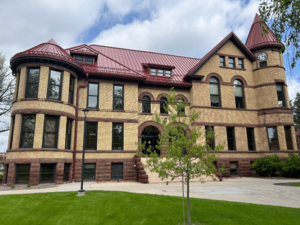
Fargo is home to North Dakota State University (NDSU). It has over 14,500 students. NDSU started in 1890 as a state university focused on farming, engineering, and science. Now it offers many other subjects.
NDSU, along with Minnesota State University Moorhead and Concordia College in Moorhead, form the Tri-College University system. This means students can take classes at any of the three schools. These three colleges create a lively community of over 25,000 students.
NDSCS-Fargo is a campus of North Dakota State College of Science. It offers classes and training programs.
Fargo also has other private colleges:
- Rasmussen University
- A branch of the University of Mary
- Master's Baptist College
- The University of Jamestown's Doctor of Physical Therapy program is based in Fargo.
Media in Fargo
The Forum of Fargo-Moorhead is the main newspaper in the city. The High Plains Reader is an independent weekly newspaper. North Dakota State University's student newspaper, The Spectrum, is printed twice a week during the school year.
Fargo also has many radio and television stations. Some of the TV stations include:
- KVLY-TV (NBC)
- KXJB-LD (CBS)
- KVRR (Fox)
- WDAY-TV (ABC)
- KRDK-TV (MyNetworkTV)
- KFME-TV (PBS)
There are also many radio stations that play different types of music and talk shows.
Transportation in Fargo
Fargo is an important transportation center for the area. It has two major interstate highways, two main railroads, and an airport.
Hector International Airport serves Fargo. It has the longest public runway in North Dakota.
The Fargo-Moorhead area has a bus service called MATBUS. The buses run Monday through Saturday. Many routes are designed for college students, who make up half of the riders. Other bus services like Greyhound Lines and Jefferson Lines also connect Fargo to other cities.
The BNSF Railway runs through Fargo. Amtrak passenger trains, like the Empire Builder, stop at the Fargo Amtrak station every day.
The city is located where Interstate 29 and Interstate 94 meet. U.S. Highway 81, U.S. Highway 10, and U.S. Highway 52 also go through Fargo.
Fargo's streets are set up in a grid pattern. Roads that go north to south are called streets. Roads that go east to west are called avenues.
Some major north-south roads are:
- 45th Street
- 42nd Street
- Interstate 29
- 25th Street
- University Drive
Some major east-west roads are:
- 40th Avenue Northwest
- 19th Avenue North
- Main Avenue
- 13th Avenue South
- Interstate 94
- 32nd Avenue South
- 52nd Avenue South
Famous People from Fargo
Sister Cities
Fargo has three sister cities:
- Hamar, Norway
- Vimmerby, Sweden
- Martin, Slovakia
See also
 In Spanish: Fargo (Dakota del Norte) para niños
In Spanish: Fargo (Dakota del Norte) para niños


